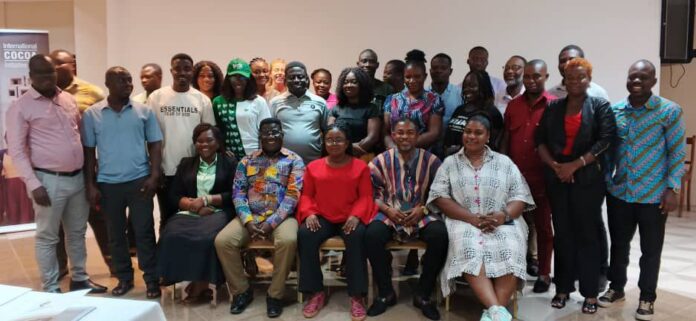As cocoa production increases in Ghana, child advocacy groups are intensifying calls and efforts to militate against child labour in the sector.
Production of the cocoa bean is expected to climb to about 700,000 tonnes for the 2025/26 season from 531,000 tonnes in the previous season.
The International Cocoa Initiative (ICI) observes that the growth in cocoa production translates to an expanded number of farming households, which increases the number of children at risk.
The cocoa advocacy organization is urging the media to take an active role in the fight against child labour in the cocoa sector, stressing that the media is a powerful force in shaping public opinion and driving change within farming communities.
Communications Director of ICI, Katie Bird, emphasized the need to double efforts to rid the cocoa value chain of any practices that infringe on the rights of children.
“That makes it even more important that we double down our efforts and put real energy into addressing this issue,” Bird urged.
She highlighted the long-term physical and psychological impacts child labour poses to children in cocoa growing communities.
“Child labour is harmful to children to their mental, physical and emotional development. What we really want to do is to give children and cocoa farming families more widely a better future,” she emphasized.
She also stressed the shared responsibility and collective collaboration among multiple stakeholders, including cocoa and chocolate companies, governments in both producing and consuming countries, farming households, and critically, the media to tack the menace.
“We believe all actors have a role to play in tackling a challenge such as child labour. But really importantly and crucially, we believe that the media also has a role to play in tackling child labour in cocoa,” Katie Bird explained during a training session for journalists focusing on agriculture and cocoa-related issues.
The ICI, in partnership with the Ghana Agricultural and Rural Development Journalists Association, held a two-day training session on child labour and forced labour in the cocoa sector.
The training provided a platform for dialogue, equipped journalists with more information, and explored ways to support media reportage on these human rights violations.
“We wanted to exchange and discuss with members of the media the challenges they may face, and the ways that we as an organization can support them moving forward,” Ms Bird added.
She is positive the training would conscientize participants to emerge as agents of change.
“Often journalists, whether radio or print, especially at the regional level, are respected voices. If you as individuals can be agents of change, then that’s a way of moving forward and developing,” she said.
Reflecting on progress made, Ms. Bird noted that 20 years of work in the sector have deepened understanding of both the causes and the solutions to child labour in the sector.
“We now know a lot more about what works to tackle child labour access to quality education, school infrastructure, alternative income opportunities, household income, and women’s empowerment are all key factors,” she stated.
She continued that: “The positive sign is that we are much better placed today than in the past to make progress. But it will take collective action, and the media is an essential part of that journey”.
President of the GARDJA, Richmond Frimpong, charged participants to employ the skills and knowledge gained from the training in their reportage to drive change.
He reiterated the media efforts in spotlighting issues on human right infringements in the cocoa sector for a healthy cocoa production.
Source: Stephanie Frimpong/Emmanuel Bright Quaicoe


